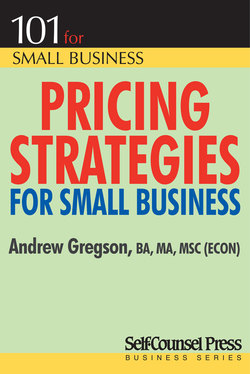Читать книгу Pricing Strategies for Small Business - Andrew Gregson - Страница 3
ОглавлениеIntroduction
How to Get the Most from This Book
I have written this book as a journey that seeks to explore the nooks and crannies of pricing, since it is a matter of great concern for small businesses. As such, it is long and involved.
If you have the leisure to read this book from page one to the appendices, then good for you. If, as I expect, you need to prepare a price for a customer tomorrow morning and want an answer now, then the outlines below will serve their purpose.
Although I would not normally recommend reading a book in reverse order, I believe there are instances where that is necessary — when an answer is needed tomorrow and reading the entire book and absorbing all its content is not possible.
Where to Begin If You Need to Solve a Pricing Problem Tomorrow Morning
• First, read Chapter 10, “Diagnosis and Prescription: What Should I Do to Fix My Pricing?”
• Read Chapter 9 on “Financial Analysis” and Knowing Your Real Costs.
Next, choose your industry.
If you are a contractor:
• Read “Estimating Solutions” in Chapter 3, page 22 and “DIY (Do It Yourself) Estimating,” page 24.
• Read “5 Business Wreckers” in Chapter 3, page 36.
• Read “Risk and Return” in Chapter 3, page 31.
• Read Chapter 4 “Positioning for Price: The Role of the Unique Selling Proposition.”
• Read “Contracting: A Recommended Strategy for Finding the Customer’s Buying Price” in Chapter 5, page 56.
• Read about “Reference Prices” and “Gain Loss Framing” in Chapter 5, pages 64 and 69.
• Read “Nine Guidelines Presenting your Price” in Chapter 7, page 104.
• Read about “Bundling and Unbundling” in Chapter 7, page 108.
• Read “The Winner’s Curse” in Chapter 7, page 110.
• Read Chapter 7 on “Learning to Lose a Percentage of Sales,” page 109.
If you are in retailing:
• Read Chapter 4, “Positioning for Price: The Role of the Unique Selling Proposition.”
• Read “Know Your Costs” in Chapter 6, page 77.
• Read “Retailing: Testing the Water” in Chapter 5, page 56.
• Read about “Selling Best, Better, Good” in Chapter 7, page 112.
• Read “Meeting the Price Objection” in Chapter 7, page 86.
• Read about “Bundling and Unbundling” in Chapter 7, page 108.
• Read about “Reference Prices” and “Gain Loss Framing” in Chapter 5, pages 64 and 69.
If you are in a service business:
• Read Chapter 4, “Positioning for Price: The Role of the Unique Selling Proposition.”
• Read “Nine Guidelines for Presenting your Price” in Chapter 7, page 104.
• Read Chapter 7 on “Bundling and Unbundling,” page 108.
• Read about “Reference Prices” and “Gain Loss Framing” in Chapter 5, pages 64 and 69.
If you are a manufacturer:
• Read all of Chapter 8, “Pricing Models.”
• Read “Pricing Down from Value versus Pricing Up from Cost” in Chapter 5, page 54.
• Read Chapter 4, “Positioning for Price: The Role of the Unique Selling Proposition.”
When you have overcome your immediate problems, then the entirety of Chapter 5 on “Value Pricing” is designed to expose you to the most current thinking about how to offer value in your pricing. If you have constructed a solid company with the basics outlined in the financial chapters, value pricing will make your company truly profitable and valuable.
